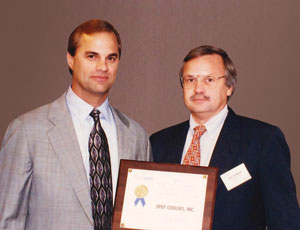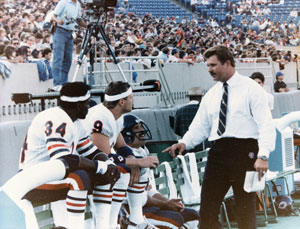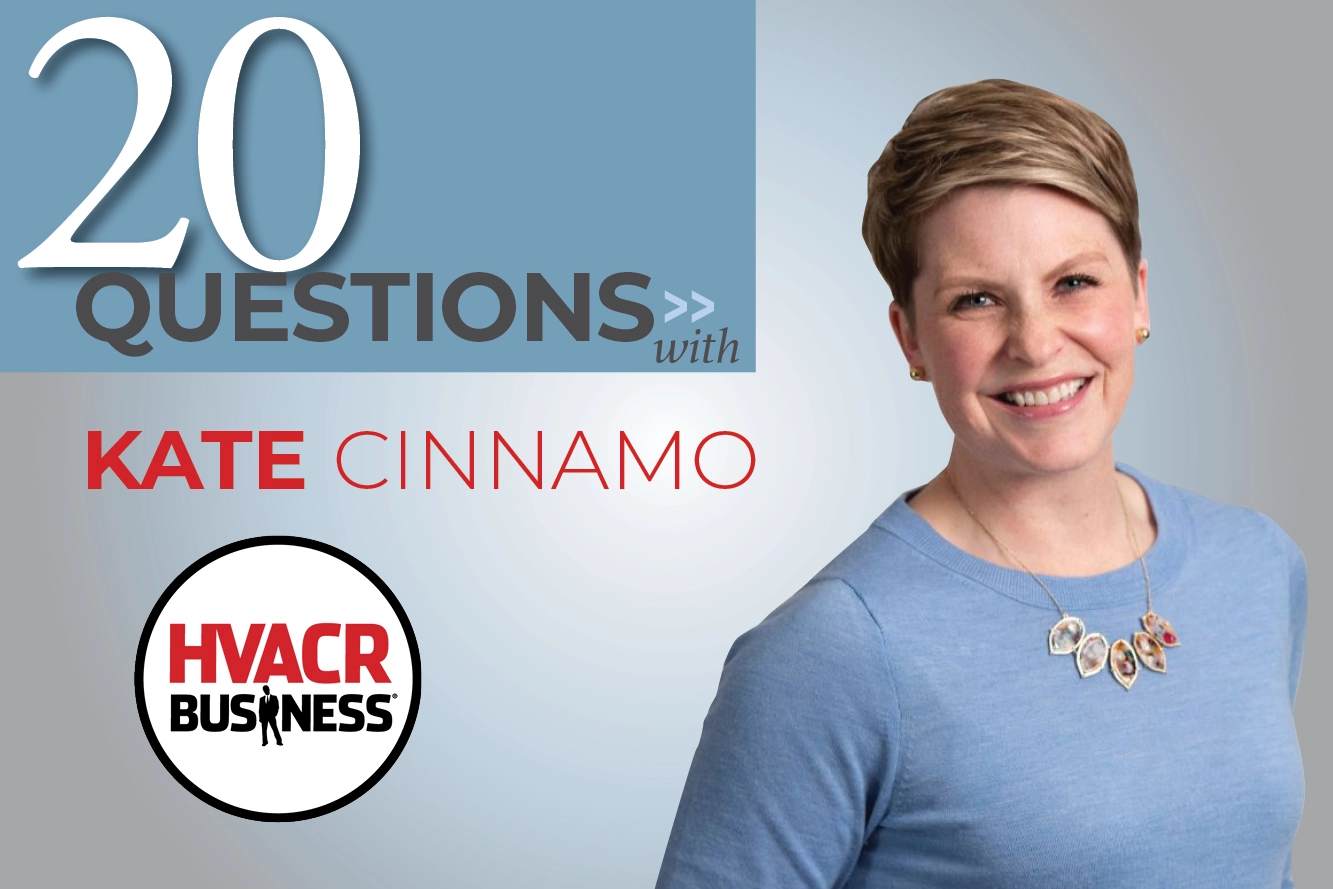Publisher Terry Tanker sat down with Ken Swanson and (the late) Garth Tagge, two entrepreneurs who started an industry by laying the foundation for spot cooling. They introduced a technology and created demand by using unique, creative and unorthodox methods. The three met on several occasion’s to discuss how it all started and how it has evolved.
Ken Swanson grew up in the HVACR industry. His grandmother was the third Copeland wholesaler in the country, and grew that business into six branches in Chicago. Swanson’s father urged him to go to college, but it was assumed that upon graduation he would join the family business.
As a result, Swanson recalls his criteria for selecting a college relied more on “the amount of fun” rather than how much he could learn. In retrospect, he realized it was not his best decision, though it certainly made his college experience more interesting.
True to the plan his father laid out, Swanson started at Chase Supply right after graduation and by the age of 24 he was running the day-to-day operations of the business as his father prepared for retirement.
It was through his work at Chase Supply that Swanson first became aware of a new innovation: portable air conditioning. This is when he also met Garth Tagge. Together, the two ambitious entrepreneurs embarked on a journey to bring this new technology to the U.S.
They didn’t have a game plan when they first started, but like any great entrepreneur, they tried new things and learned as they went along. Today, the portable air conditioning market continues to grow in importance. This is how it all got started.
 The Birth of Spot Cooling
The Birth of Spot Cooling
Swanson: In 1983, a company called Nippondenso created a spot-cooling product for “in house” use. They had about 40,000 production line employees in a half-dozen plants across Japan. During the summer months it was extremely hot and humid and, as a result, production would drastically fall. They knew they needed something to increase worker productivity. One of their productivity engineers came up with the idea of portable air conditioning.
Nippondenso had a relatively new division operating in Los Angeles and thought the product could be sold in the U.S. Garth was hired to set up a distribution network for the product. Seven states were identified as targets and he began calling on distributors to introduce the product and try to get them to carry this new product.
Tagge: We just hit it off. There’s a funny story about our first meeting.
Swanson: The first sales call, he comes in with his Japanese boss. It’s about 98 degrees in Chicago and they’re in wool suits and a van that’s not air-conditioned with a spot cooler in the back for “show and tell.” They want to demo the spot cooler with the Japanese boss ... but he doesn’t speak English.
I usually worked the counter and we were always busy. So, I invited them back to my office. The Japanese guy is trying to sell this product in Japanese with a Japanese brochure. The brochure has a blonde in a bikini displayed with the product. The brochure is in Japanese, and he’s speaking Japanese, so I’m polite and listen to the pitch then look at Garth and ask him, “What the hell did he just say?”
At the end of the meeting I tell them “I’ll take 10, if I can have exclusive rights to distribute in the state of Illinois.”
Tagge: It was a good day and we repeated it several more times. My boss called Ken “mustache man.” Whenever I’d tell him I was going on a sales trip, he’d ask where and I’d say, “to see the mustache man.” He’d give me a big smile.
At some point, we’d sold 40 units to Ken and he had exclusive rights to distribute in four states — Illinois, Georgia, Florida and Texas — as well as an 800-phone number.
Creating a Market
Swanson: There was a problem — there was no one to sell to at first. We had 40 units just sitting in the warehouse. We were trying to figure out who we could sell these to.
I would work the counter with the service guys. I liked talking to people, and service guys would come in and we’d have donuts and coffee. I’d shoot the breeze with them to get a feel for what was going on.
We always had a unit out on the floor, and they would say, “You’re nuts! Two thousand bucks a ton, (versus $400 for a standard unit) you’re out of your mind. No one is going to buy one of those. Where would we even use it? No ducting, no nothing. It just blows cold air.”
I had the units for a while and Nippondenso wanted to be paid. I apologized to Garth and told him to take them back, because there wasn’t a market for them here. But Garth came up with a clever idea.
He suggested to his boss that he should come to work for me for 10 days a month to help figure out the market.
Tagge: Our challenge wasn’t building a business. The challenge was building an industry so that we could build a business around the industry we created.
Swanson: Thinking back, we needed to create an industry around a product no one knew about or even considered they needed. It’s not like there were places you could go to rent an air conditioner for two days. There was nothing like that.
A Bear of an Inspiration
Tagge: I’ll never forget this. We were sitting in the kitchen at the office, it was 1985, and it was really hot and really humid. Ken had season tickets for the Bears. I said, “Let’s call the (Chicago) Bears and see if we can get on the sideline with our “people cooler.” We get a hold of Tim LeFevour, the Bears equipment manager.
We tell him “We’ve got a product I think you’re going to like.” Obviously, he’s heard this pitch a thousand times and we can tell he’s not interested. So, we say the (Dallas) Cowboys just bought eight of them and he tells us to come on down.
We put a unit in the back of one of the wholesale vans, and off we go to the stadium. We plug it in — it’s just one nozzle, 300 CFM — and the air that’s blowing out is 20F cooler than ambient.
 All of a sudden, Mike Ditka comes walking over with Walter Payton. Payton sits down to feel the air blowing on him and Ditka says, “What do you think?” Payton replies, “That feels nice; I like it.” Ditka says, “That unit is yours. Everybody else stay away from it.”
All of a sudden, Mike Ditka comes walking over with Walter Payton. Payton sits down to feel the air blowing on him and Ditka says, “What do you think?” Payton replies, “That feels nice; I like it.” Ditka says, “That unit is yours. Everybody else stay away from it.”
LeFevour looks at us after the practice and says, “Okay, we’ll talk it over and let you guys know.” He calls us a couple days later and asks us to bring eight of them for Saturday night’s preseason game (the home team has to give the visitor the same thing they have). We put four on the visitor’s side, and four on the Bears side.
From that point on, if it was 60 degrees or above we brought eight units — four for the Bears and four for the visitor.
When the Bears went on the road we would meet them. All the outdoor stadiums were designed so the home team was in the shade and the visitor was in the sun. One Sunday, the Bears are in Miami playing the Dolphins. Kickoff is supposed to be 1 p.m. but its already1:05.
Legendary Dolphin’s Coach Don Shula is on the phone with the NFL New York office, telling them the Bears brought in air conditioners for their sidelines, wanting to know if it was legal. The League office checked the rulebook and said, yes, it’s okay.
So, the game finally starts at 1:08 p.m. and the Bears have air conditioning, but the Dolphins do not. We got a lot of calls after that. It was really exciting, because from that point on we had credibility. We started working with the Cowboys, Oilers and, eventually, the Dolphins.
Reach Beyond the Goal Line
Tagge: At first, the NFL is what we focused on. Remember, up until this point the only application for the product was an assembly line. Unfortunately, at that time, the cost of the product was $2000 per ton. It was an extremely expensive product so we didn’t have any success pushing that through to the end user. Managers in the U.S. didn’t want the added expense, largely due to union wages. We’d been at it almost two years and were thinking this might not work. Luckily, the NFL gave us the exposure we needed.
Swanson: I went to a convention in Boca Raton and I stayed at the Boca Hotel and loved it. I had exclusive rights to Florida, so I ended up renting a small warehouse to store 10 units. We started marketing the product to hospitals in Florida. I’d get a phone call and leave the wholesale business, go to Midway, get on a plane, fly to Fort Lauderdale, get a car, go to the warehouse, load the van, deliver the units to the hospital, put the van back in the warehouse, go back to the airport and get on a plane back to Chicago.
Part of our marketing was promising 24 hour service. I was doing this 3 or 4 times a week — and learning each trip I made. Eventually, I bought a condo, which made things a lot easier.
Midway Airlines knew me pretty well and they’d always upgrade me to first class. One day I get on the plane and I’m next to the window, and who sits next to me but Don Shula. He had been at Mike Ditka’s breast cancer fundraiser golf outing.
The guy sitting across the aisle doesn’t give him a break and talks to him the whole flight. We’re getting close to landing so I take out a brochure and have it in my lap. Finally, Shula gets a break and looks over at me and asks me what I do. I say, “Do you remember those air conditioners on the Bears’ sidelines last year where you stopped the game? Well, we’re the guys that sell them.” He asks for my card and I tell him I’ll even write my cell number down on the back. The funny thing is, I didn’t have a cell phone — you know those giant things they called a “brick.” Instead, I wrote down my home number.
I’ll never forget … my wife and I had just moved down to Boca. It’s Saturday afternoon and the phone rings and my wife says, “Don Shula’s on the phone.” He wanted me to bring “some of those air conditioners” to the game the next day. I told him I’d look into our schedule and see what we could do.
We went all over the country for a couple of years providing air conditioning for all the teams — it was great. We didn’t have a competitor. If you wanted AC on the sideline, you had to call us.
Tagge: Unfortunately, working with the NFL cost us money. We didn’t charge them anything. We were after the exposure and credibility. We didn’t care where the games were being played, we would ship the units to the stadiums. We knew the announcers were going to talk about how hot it was on the field and it never failed. A reporter would be on the sidelines next to one of our units in front of a national TV audience talking about the technology and about how the units were helping to keep the players cool.
We were young, carefree and having a great time going to all of those games and being on the sidelines. Don’t forget, we both had our “day jobs” too. But, we were getting exposure we literally couldn’t buy.
Swanson: There was one Sunday night game where we were walking around looking up into the stands after setting up the units when we see Jim Belushi trying to get down onto the field, but the ushers won’t let him. Everyone knows he’s a Chicago guy and huge fan, but there’s no way he can get on the field because he doesn’t have a pass. We get his attention and tell him we have an extra sideline pass. His eyes light up. We slip him the pass, and now he’s as good as gold and gets on the field. We’ve got dozens of stories like that. It was just a lot of fun.
We did fun things back at the supply house too. We’d bring the units back from a game slap some mud and grass on them and put it on the show room floor. Guys would come in and say, “I saw that on TV yesterday.” We’d tell them “That’s the one ‘The Fridge’ (William Perry) or Walter Payton knocked into,” or, “That’s the one Richard Dent and Matt Suhey used.”
We’d sell those units to guys who just wanted them in their garages to tell their friends and neighbors. Then we started taking pictures on the sidelines of the players next to the units — thousands of pictures. We’d use a magic marker and put W.P or R.D on the unit and say,
“Yeah, that’s Payton’s unit,” or “That’s Dent’s unit.”
Tagge: After a period of time, the exposure really paid off and units started to sell. We’d go on sales calls and show them the unit and say, it’s a portable air conditioner. All we had to do was ask if they’d seen the game last week and if they noticed the units on the sidelines. It was a story — a great one, because everyone we were calling on could relate to it. The next thing you know, we’re at the Super Bowl and then the Sugar Bowl … we were everywhere.
Publisher’s Note: To be continiued next month ... stay tuned to find out how spot cooling went from NFL novelty to mainstream industry solution.


 The Birth of Spot Cooling
The Birth of Spot Cooling All of a sudden, Mike Ditka comes walking over with Walter Payton. Payton sits down to feel the air blowing on him and Ditka says, “What do you think?” Payton replies, “That feels nice; I like it.” Ditka says, “That unit is yours. Everybody else stay away from it.”
All of a sudden, Mike Ditka comes walking over with Walter Payton. Payton sits down to feel the air blowing on him and Ditka says, “What do you think?” Payton replies, “That feels nice; I like it.” Ditka says, “That unit is yours. Everybody else stay away from it.”



